Wind Turbine Design Report: CAD Modelling, Analysis and Simulation
VerifiedAdded on 2023/06/15
|17
|1904
|55
Report
AI Summary
This report details the design and analysis of a wind turbine, emphasizing its role in renewable energy. It covers essential components like blades (manufactured using AISI 304 stainless steel), the foundation (made of plain carbon steel), the power box (constructed from alloy steel), and the turbine tower (also made of plain carbon steel). The report includes an assembly procedure and a stress analysis simulation, calculating forces on the blades due to wind velocity, drag, and lift. Mesh information and analysis results, including Von Mises stress, displacement, and strain, are presented. The conclusion highlights the turbine's efficient design under maximum wind conditions, referencing industrial standards and relevant academic sources. Desklib provides access to this and other student-contributed assignments.

WIND TURBINE DESIGN REPORT
REPORT
ON
WIND TURBINE CAD MODELLING & ANALYSIS
1 | P a g e
REPORT
ON
WIND TURBINE CAD MODELLING & ANALYSIS
1 | P a g e
Paraphrase This Document
Need a fresh take? Get an instant paraphrase of this document with our AI Paraphraser
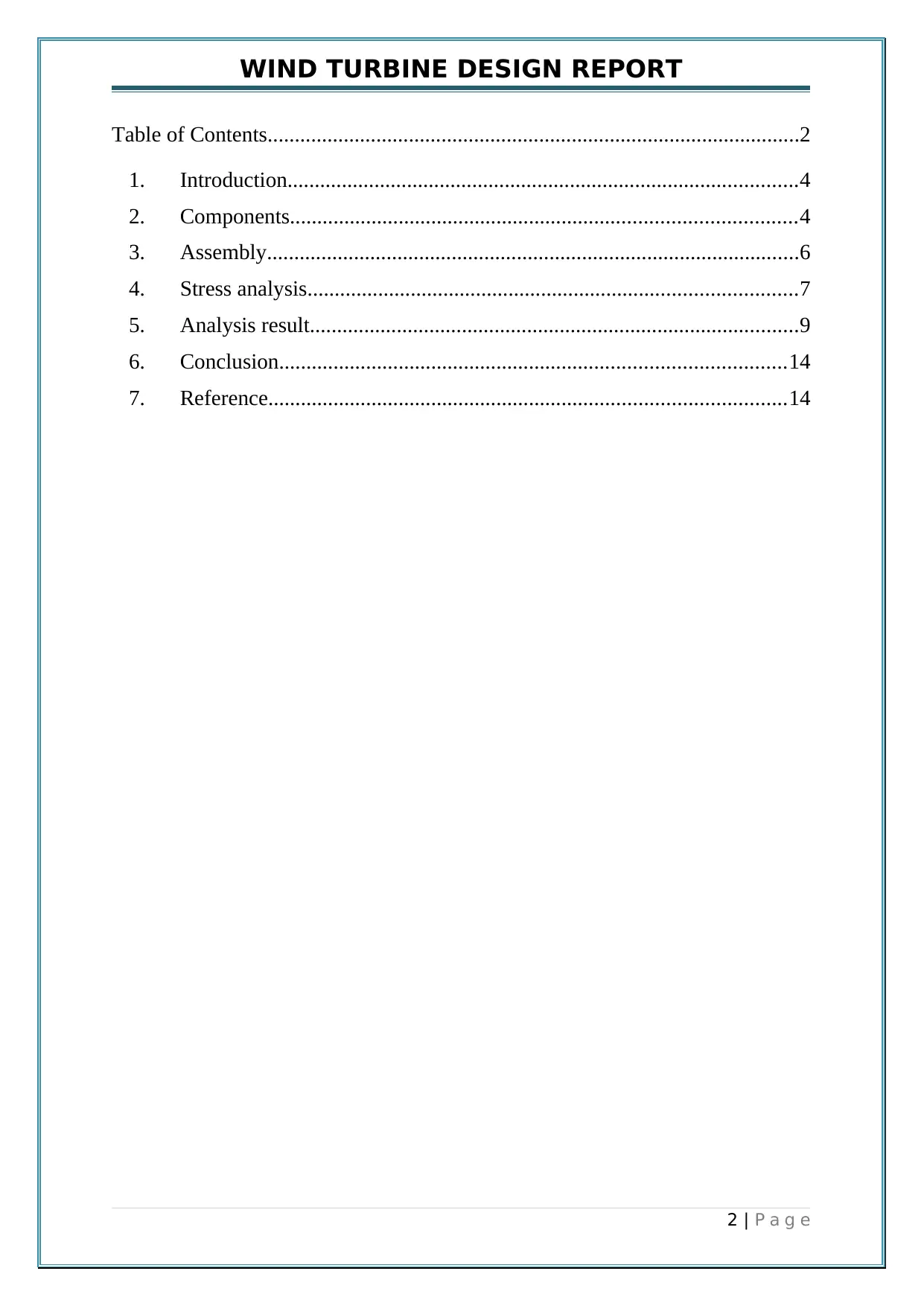
WIND TURBINE DESIGN REPORT
Table of Contents..................................................................................................2
1. Introduction..............................................................................................4
2. Components.............................................................................................4
3. Assembly..................................................................................................6
4. Stress analysis..........................................................................................7
5. Analysis result..........................................................................................9
6. Conclusion.............................................................................................14
7. Reference...............................................................................................14
2 | P a g e
Table of Contents..................................................................................................2
1. Introduction..............................................................................................4
2. Components.............................................................................................4
3. Assembly..................................................................................................6
4. Stress analysis..........................................................................................7
5. Analysis result..........................................................................................9
6. Conclusion.............................................................................................14
7. Reference...............................................................................................14
2 | P a g e

WIND TURBINE DESIGN REPORT
1. ABSTRACT
Now a days Renewable power era can assist international locations meet their
sustainable development dreams by imparting an get secure, clean, dependable and
low cost energy. As the Renewable energy have gain more importance, due to large
amount of power generation capacity today by renewable sources. The Renewable
energy industry having a worth of thousands of billions dollars because of hundreds
of gigawatts and megawatts renewable plants such as wind, hydropower and solar
plants are being installed in the whole world every year. As the wind is evolve due
to the multiple heating impacts on the Earth’s surroundings with an aid of sun , the
abnormal geometry may used as a source of renewable energy. Due to the low cost
of operational and due to the fact that this is a clean source of energy, the wind
energy will becomes one of the most relevant method of producing electric power
in distinct places. So this report is used to design and analysis of wind turbine. So
this report consider the wind data of the different places to calculate the wind
speed which will act on the turbine blades.
2. INTRODUCTION
Wind turbines are now widely used in hilly areas and rural plane areas which is used
to generated electricity with the help of wind. As is renewable source of energy so
obtain from nature in abundant form. The blades on wind turbine are rotated by
wind strikes on the surface of turbine blades. The turbine blades mounted on shaft
which is coupled with gearbox and generator(dynamo) .In gearbox, the multiple
gears are coupled in such a way that output shaft get required speed in terms of
rpm. Shaft from the gearbox is coupled with generator where the electric power is
produced from the rotational motion of shaft.
“Wind Turbine Technology: Fundamental Concepts of Wind Turbine Engineering” by Spera D.A.
3 | P a g e
1. ABSTRACT
Now a days Renewable power era can assist international locations meet their
sustainable development dreams by imparting an get secure, clean, dependable and
low cost energy. As the Renewable energy have gain more importance, due to large
amount of power generation capacity today by renewable sources. The Renewable
energy industry having a worth of thousands of billions dollars because of hundreds
of gigawatts and megawatts renewable plants such as wind, hydropower and solar
plants are being installed in the whole world every year. As the wind is evolve due
to the multiple heating impacts on the Earth’s surroundings with an aid of sun , the
abnormal geometry may used as a source of renewable energy. Due to the low cost
of operational and due to the fact that this is a clean source of energy, the wind
energy will becomes one of the most relevant method of producing electric power
in distinct places. So this report is used to design and analysis of wind turbine. So
this report consider the wind data of the different places to calculate the wind
speed which will act on the turbine blades.
2. INTRODUCTION
Wind turbines are now widely used in hilly areas and rural plane areas which is used
to generated electricity with the help of wind. As is renewable source of energy so
obtain from nature in abundant form. The blades on wind turbine are rotated by
wind strikes on the surface of turbine blades. The turbine blades mounted on shaft
which is coupled with gearbox and generator(dynamo) .In gearbox, the multiple
gears are coupled in such a way that output shaft get required speed in terms of
rpm. Shaft from the gearbox is coupled with generator where the electric power is
produced from the rotational motion of shaft.
“Wind Turbine Technology: Fundamental Concepts of Wind Turbine Engineering” by Spera D.A.
3 | P a g e
⊘ This is a preview!⊘
Do you want full access?
Subscribe today to unlock all pages.

Trusted by 1+ million students worldwide
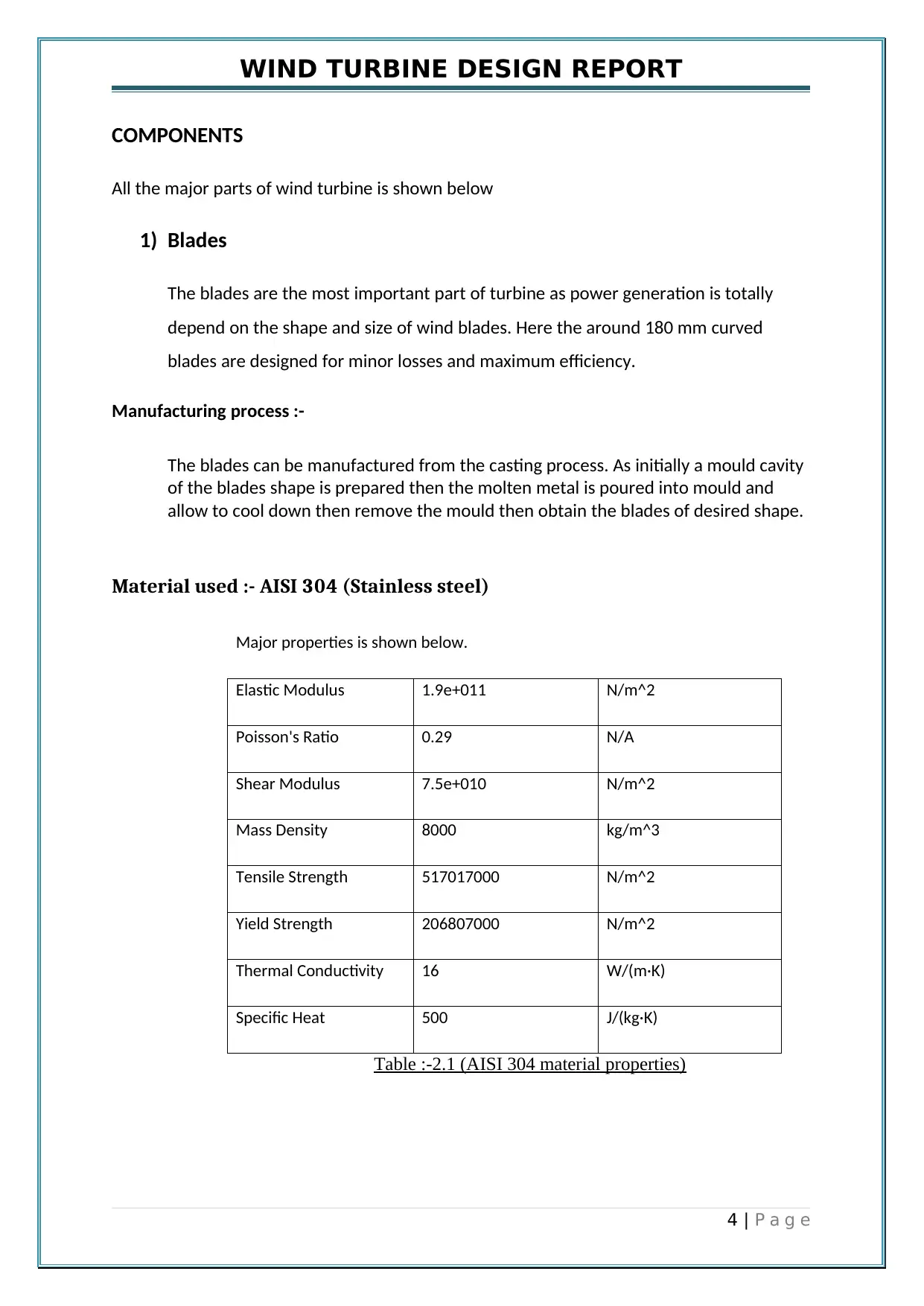
WIND TURBINE DESIGN REPORT
COMPONENTS
All the major parts of wind turbine is shown below
1) Blades
The blades are the most important part of turbine as power generation is totally
depend on the shape and size of wind blades. Here the around 180 mm curved
blades are designed for minor losses and maximum efficiency.
Manufacturing process :-
The blades can be manufactured from the casting process. As initially a mould cavity
of the blades shape is prepared then the molten metal is poured into mould and
allow to cool down then remove the mould then obtain the blades of desired shape.
Material used :- AISI 304 (Stainless steel)
Major properties is shown below.
Elastic Modulus 1.9e+011 N/m^2
Poisson's Ratio 0.29 N/A
Shear Modulus 7.5e+010 N/m^2
Mass Density 8000 kg/m^3
Tensile Strength 517017000 N/m^2
Yield Strength 206807000 N/m^2
Thermal Conductivity 16 W/(m·K)
Specific Heat 500 J/(kg·K)
Table :-2.1 (AISI 304 material properties)
4 | P a g e
COMPONENTS
All the major parts of wind turbine is shown below
1) Blades
The blades are the most important part of turbine as power generation is totally
depend on the shape and size of wind blades. Here the around 180 mm curved
blades are designed for minor losses and maximum efficiency.
Manufacturing process :-
The blades can be manufactured from the casting process. As initially a mould cavity
of the blades shape is prepared then the molten metal is poured into mould and
allow to cool down then remove the mould then obtain the blades of desired shape.
Material used :- AISI 304 (Stainless steel)
Major properties is shown below.
Elastic Modulus 1.9e+011 N/m^2
Poisson's Ratio 0.29 N/A
Shear Modulus 7.5e+010 N/m^2
Mass Density 8000 kg/m^3
Tensile Strength 517017000 N/m^2
Yield Strength 206807000 N/m^2
Thermal Conductivity 16 W/(m·K)
Specific Heat 500 J/(kg·K)
Table :-2.1 (AISI 304 material properties)
4 | P a g e
Paraphrase This Document
Need a fresh take? Get an instant paraphrase of this document with our AI Paraphraser
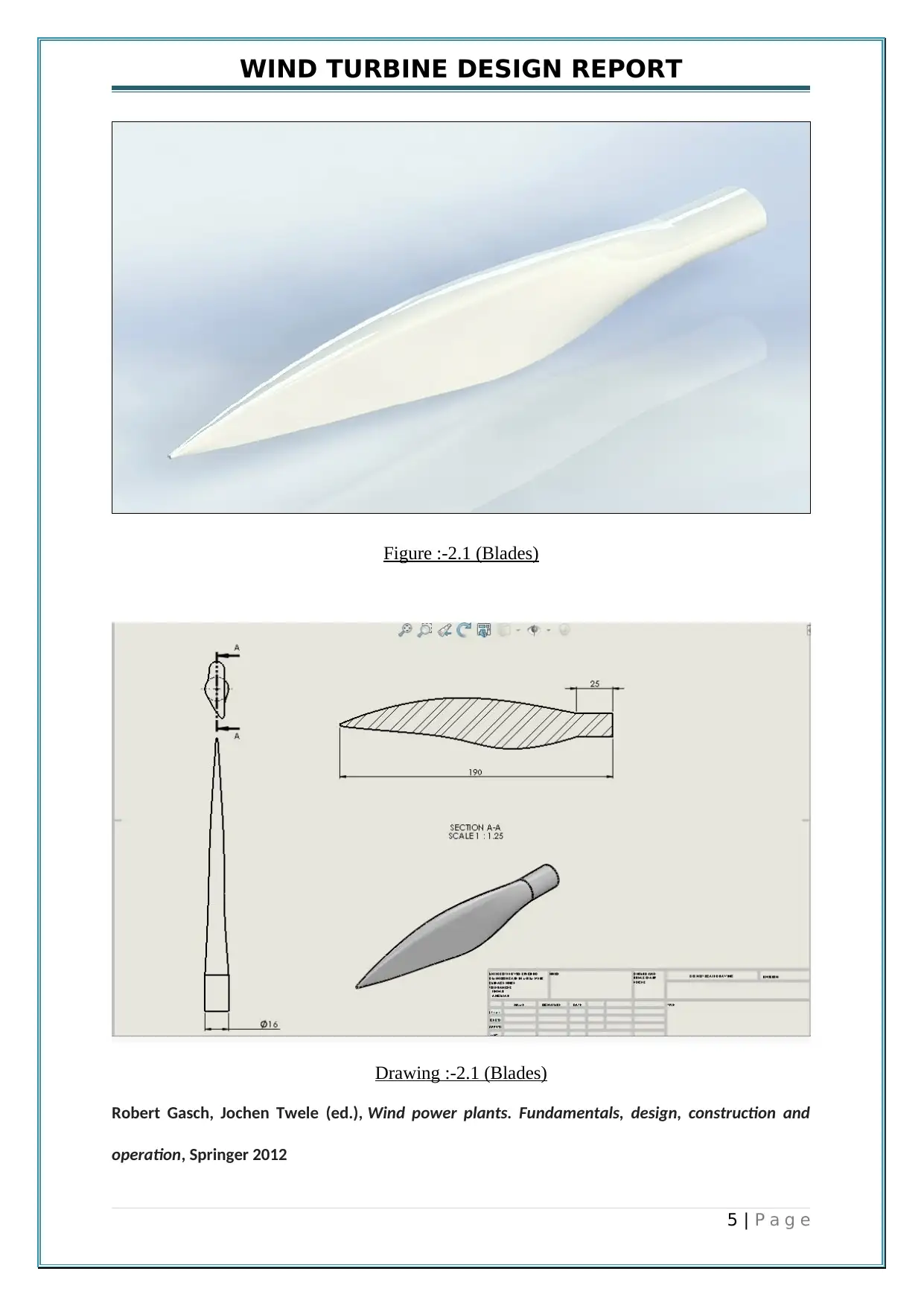
WIND TURBINE DESIGN REPORT
Figure :-2.1 (Blades)
Drawing :-2.1 (Blades)
Robert Gasch, Jochen Twele (ed.), Wind power plants. Fundamentals, design, construction and
operation, Springer 2012
5 | P a g e
Figure :-2.1 (Blades)
Drawing :-2.1 (Blades)
Robert Gasch, Jochen Twele (ed.), Wind power plants. Fundamentals, design, construction and
operation, Springer 2012
5 | P a g e
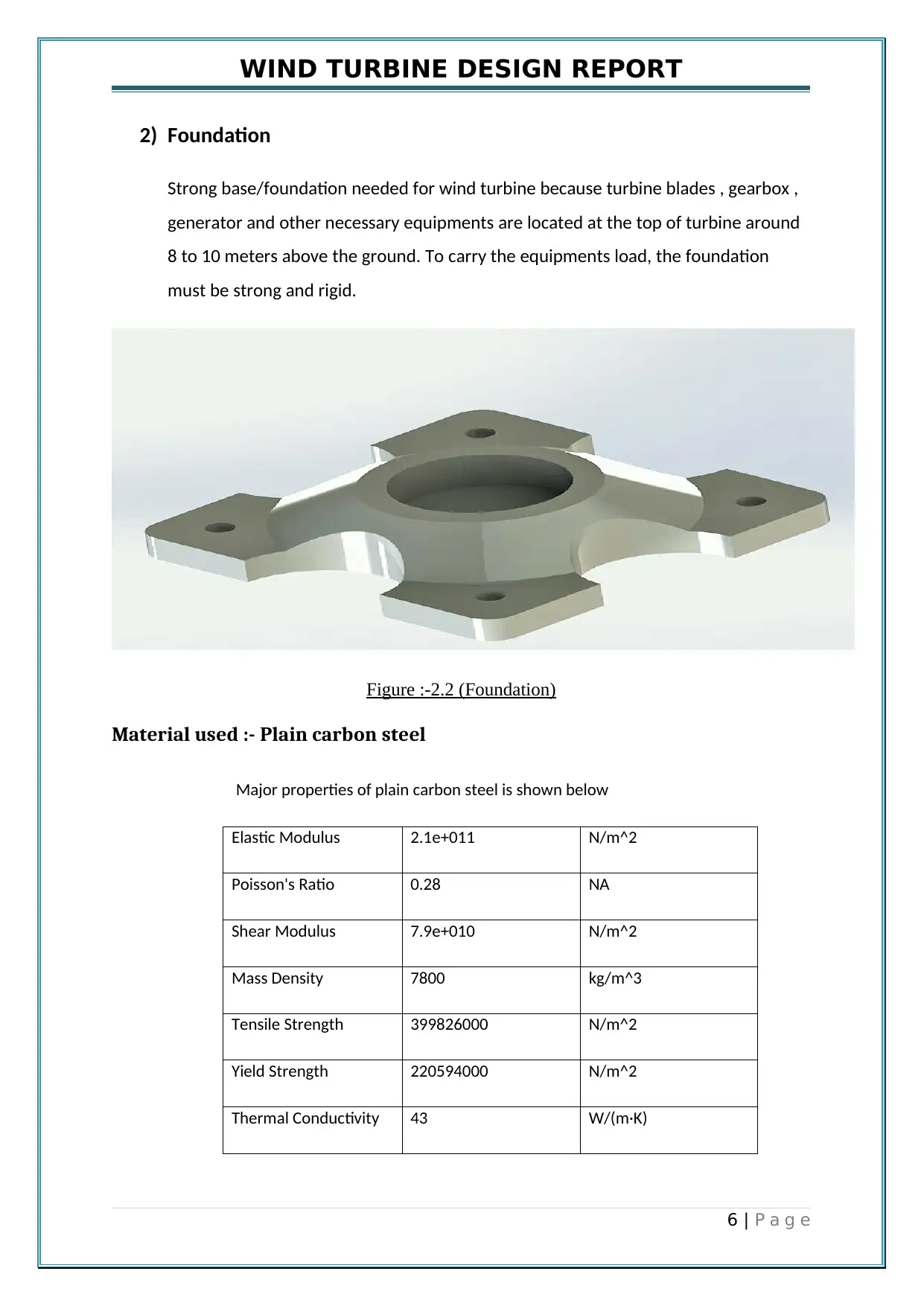
WIND TURBINE DESIGN REPORT
2) Foundation
Strong base/foundation needed for wind turbine because turbine blades , gearbox ,
generator and other necessary equipments are located at the top of turbine around
8 to 10 meters above the ground. To carry the equipments load, the foundation
must be strong and rigid.
Figure :-2.2 (Foundation)
Material used :- Plain carbon steel
Major properties of plain carbon steel is shown below
Elastic Modulus 2.1e+011 N/m^2
Poisson's Ratio 0.28 NA
Shear Modulus 7.9e+010 N/m^2
Mass Density 7800 kg/m^3
Tensile Strength 399826000 N/m^2
Yield Strength 220594000 N/m^2
Thermal Conductivity 43 W/(m·K)
6 | P a g e
2) Foundation
Strong base/foundation needed for wind turbine because turbine blades , gearbox ,
generator and other necessary equipments are located at the top of turbine around
8 to 10 meters above the ground. To carry the equipments load, the foundation
must be strong and rigid.
Figure :-2.2 (Foundation)
Material used :- Plain carbon steel
Major properties of plain carbon steel is shown below
Elastic Modulus 2.1e+011 N/m^2
Poisson's Ratio 0.28 NA
Shear Modulus 7.9e+010 N/m^2
Mass Density 7800 kg/m^3
Tensile Strength 399826000 N/m^2
Yield Strength 220594000 N/m^2
Thermal Conductivity 43 W/(m·K)
6 | P a g e
⊘ This is a preview!⊘
Do you want full access?
Subscribe today to unlock all pages.

Trusted by 1+ million students worldwide

WIND TURBINE DESIGN REPORT
Specific Heat 440 J/(kg·K)
Table :-2.2 (Plain carbon steel material
properties)
Manufacturing process :-
Metal cutting operation of desired shape act on the plate followed by drilling and
machining.
3) Power Box
The power box mounted at the top of rod. The poer box consist of turbine hub, shaft
,bearings,gearbox,genereator.The rotation of turbine blades is converted into
electricity by means of all the components present inside the power box.
Manufacturing process :-
Plate is bend in the boc form follower by welding and machining operation.
Masters, G. M. (2004). Renewable and Efficient Electric Power Systems.
7 | P a g e
Specific Heat 440 J/(kg·K)
Table :-2.2 (Plain carbon steel material
properties)
Manufacturing process :-
Metal cutting operation of desired shape act on the plate followed by drilling and
machining.
3) Power Box
The power box mounted at the top of rod. The poer box consist of turbine hub, shaft
,bearings,gearbox,genereator.The rotation of turbine blades is converted into
electricity by means of all the components present inside the power box.
Manufacturing process :-
Plate is bend in the boc form follower by welding and machining operation.
Masters, G. M. (2004). Renewable and Efficient Electric Power Systems.
7 | P a g e
Paraphrase This Document
Need a fresh take? Get an instant paraphrase of this document with our AI Paraphraser
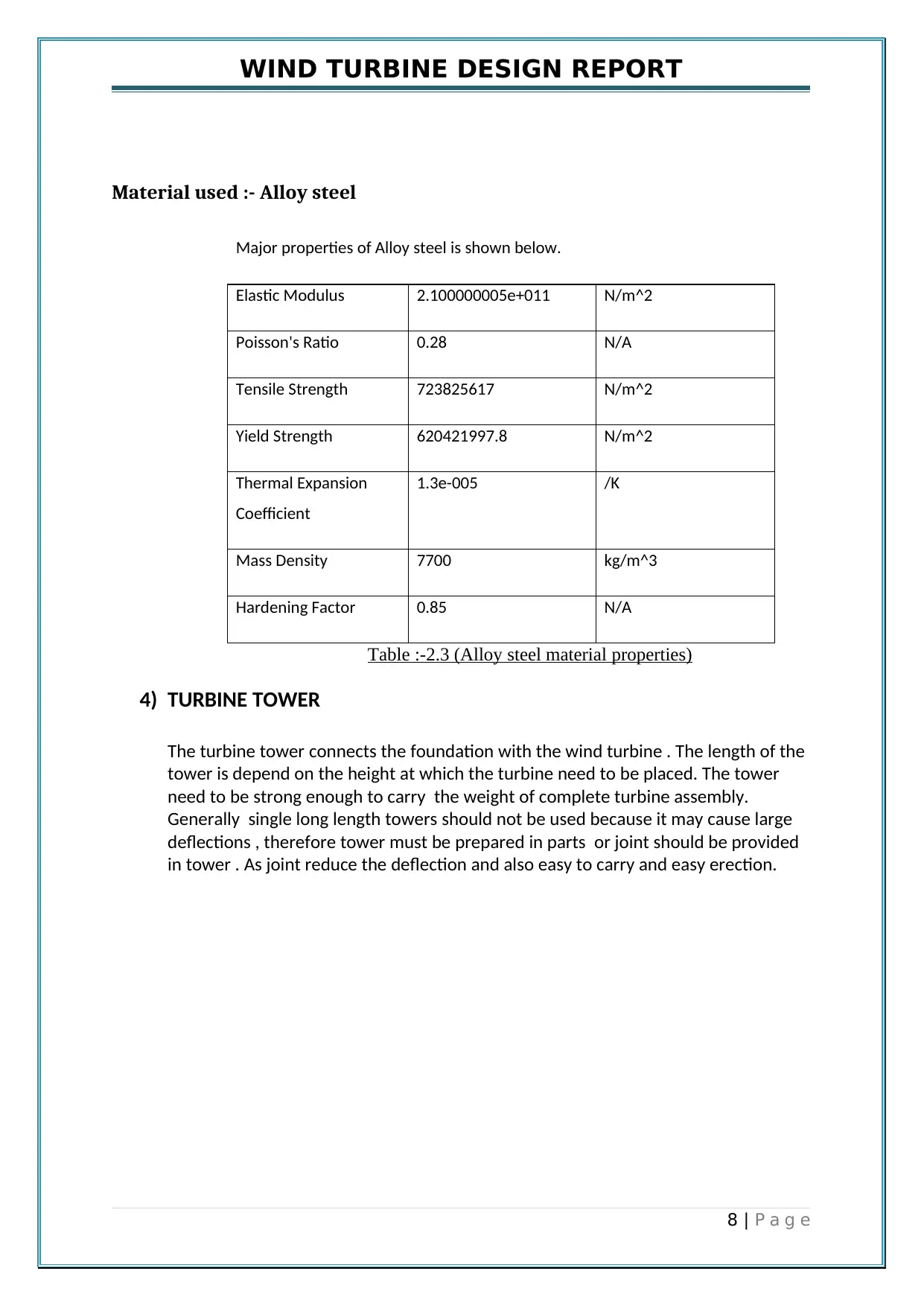
WIND TURBINE DESIGN REPORT
Material used :- Alloy steel
Major properties of Alloy steel is shown below.
Elastic Modulus 2.100000005e+011 N/m^2
Poisson's Ratio 0.28 N/A
Tensile Strength 723825617 N/m^2
Yield Strength 620421997.8 N/m^2
Thermal Expansion
Coefficient
1.3e-005 /K
Mass Density 7700 kg/m^3
Hardening Factor 0.85 N/A
Table :-2.3 (Alloy steel material properties)
4) TURBINE TOWER
The turbine tower connects the foundation with the wind turbine . The length of the
tower is depend on the height at which the turbine need to be placed. The tower
need to be strong enough to carry the weight of complete turbine assembly.
Generally single long length towers should not be used because it may cause large
deflections , therefore tower must be prepared in parts or joint should be provided
in tower . As joint reduce the deflection and also easy to carry and easy erection.
8 | P a g e
Material used :- Alloy steel
Major properties of Alloy steel is shown below.
Elastic Modulus 2.100000005e+011 N/m^2
Poisson's Ratio 0.28 N/A
Tensile Strength 723825617 N/m^2
Yield Strength 620421997.8 N/m^2
Thermal Expansion
Coefficient
1.3e-005 /K
Mass Density 7700 kg/m^3
Hardening Factor 0.85 N/A
Table :-2.3 (Alloy steel material properties)
4) TURBINE TOWER
The turbine tower connects the foundation with the wind turbine . The length of the
tower is depend on the height at which the turbine need to be placed. The tower
need to be strong enough to carry the weight of complete turbine assembly.
Generally single long length towers should not be used because it may cause large
deflections , therefore tower must be prepared in parts or joint should be provided
in tower . As joint reduce the deflection and also easy to carry and easy erection.
8 | P a g e
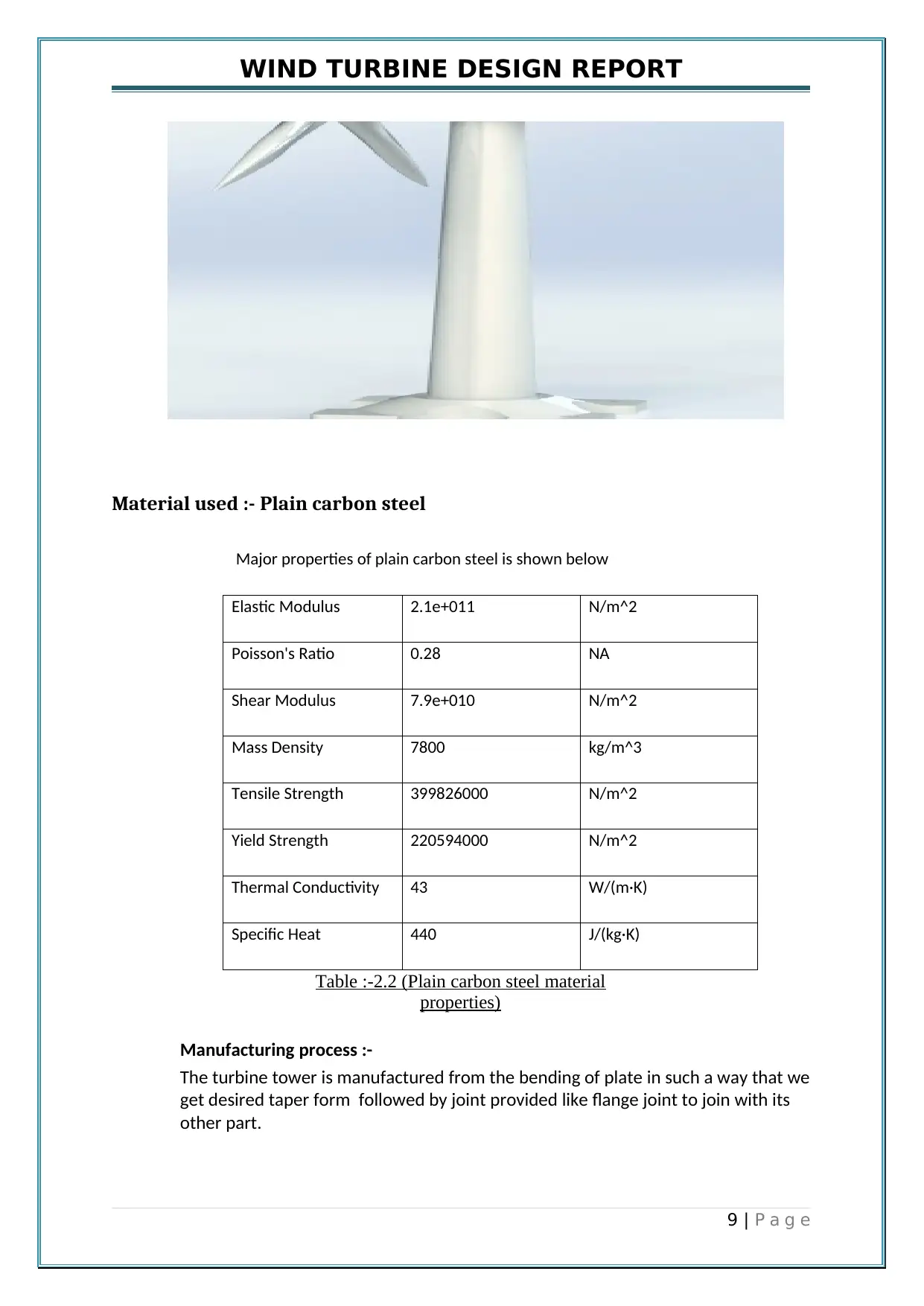
WIND TURBINE DESIGN REPORT
Material used :- Plain carbon steel
Major properties of plain carbon steel is shown below
Elastic Modulus 2.1e+011 N/m^2
Poisson's Ratio 0.28 NA
Shear Modulus 7.9e+010 N/m^2
Mass Density 7800 kg/m^3
Tensile Strength 399826000 N/m^2
Yield Strength 220594000 N/m^2
Thermal Conductivity 43 W/(m·K)
Specific Heat 440 J/(kg·K)
Table :-2.2 (Plain carbon steel material
properties)
Manufacturing process :-
The turbine tower is manufactured from the bending of plate in such a way that we
get desired taper form followed by joint provided like flange joint to join with its
other part.
9 | P a g e
Material used :- Plain carbon steel
Major properties of plain carbon steel is shown below
Elastic Modulus 2.1e+011 N/m^2
Poisson's Ratio 0.28 NA
Shear Modulus 7.9e+010 N/m^2
Mass Density 7800 kg/m^3
Tensile Strength 399826000 N/m^2
Yield Strength 220594000 N/m^2
Thermal Conductivity 43 W/(m·K)
Specific Heat 440 J/(kg·K)
Table :-2.2 (Plain carbon steel material
properties)
Manufacturing process :-
The turbine tower is manufactured from the bending of plate in such a way that we
get desired taper form followed by joint provided like flange joint to join with its
other part.
9 | P a g e
⊘ This is a preview!⊘
Do you want full access?
Subscribe today to unlock all pages.

Trusted by 1+ million students worldwide
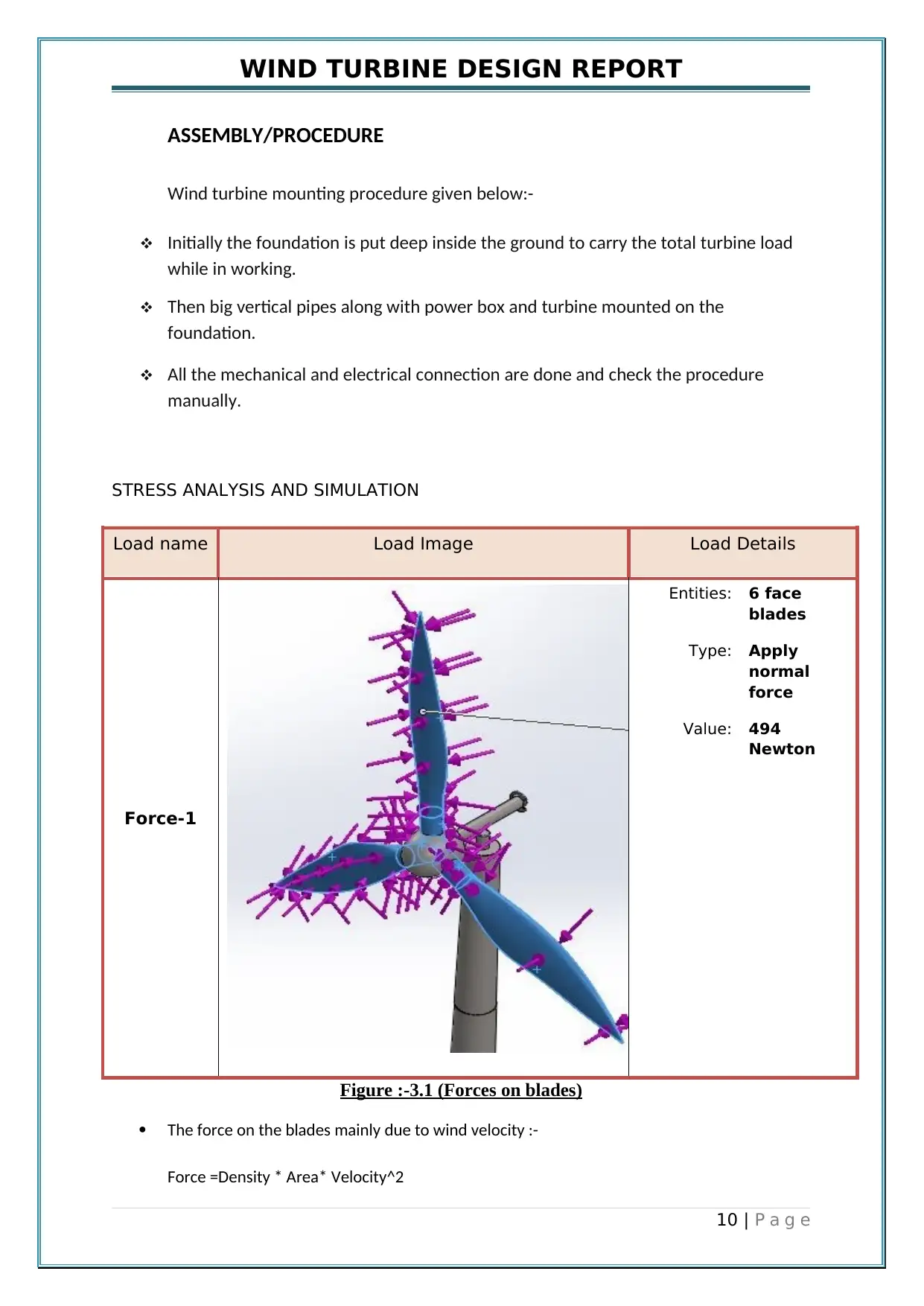
WIND TURBINE DESIGN REPORT
ASSEMBLY/PROCEDURE
Wind turbine mounting procedure given below:-
Initially the foundation is put deep inside the ground to carry the total turbine load
while in working.
Then big vertical pipes along with power box and turbine mounted on the
foundation.
All the mechanical and electrical connection are done and check the procedure
manually.
STRESS ANALYSIS AND SIMULATION
Load name Load Image Load Details
Force-1
Entities: 6 face
blades
Type: Apply
normal
force
Value: 494
Newton
Figure :-3.1 (Forces on blades)
The force on the blades mainly due to wind velocity :-
Force =Density * Area* Velocity^2
10 | P a g e
ASSEMBLY/PROCEDURE
Wind turbine mounting procedure given below:-
Initially the foundation is put deep inside the ground to carry the total turbine load
while in working.
Then big vertical pipes along with power box and turbine mounted on the
foundation.
All the mechanical and electrical connection are done and check the procedure
manually.
STRESS ANALYSIS AND SIMULATION
Load name Load Image Load Details
Force-1
Entities: 6 face
blades
Type: Apply
normal
force
Value: 494
Newton
Figure :-3.1 (Forces on blades)
The force on the blades mainly due to wind velocity :-
Force =Density * Area* Velocity^2
10 | P a g e
Paraphrase This Document
Need a fresh take? Get an instant paraphrase of this document with our AI Paraphraser
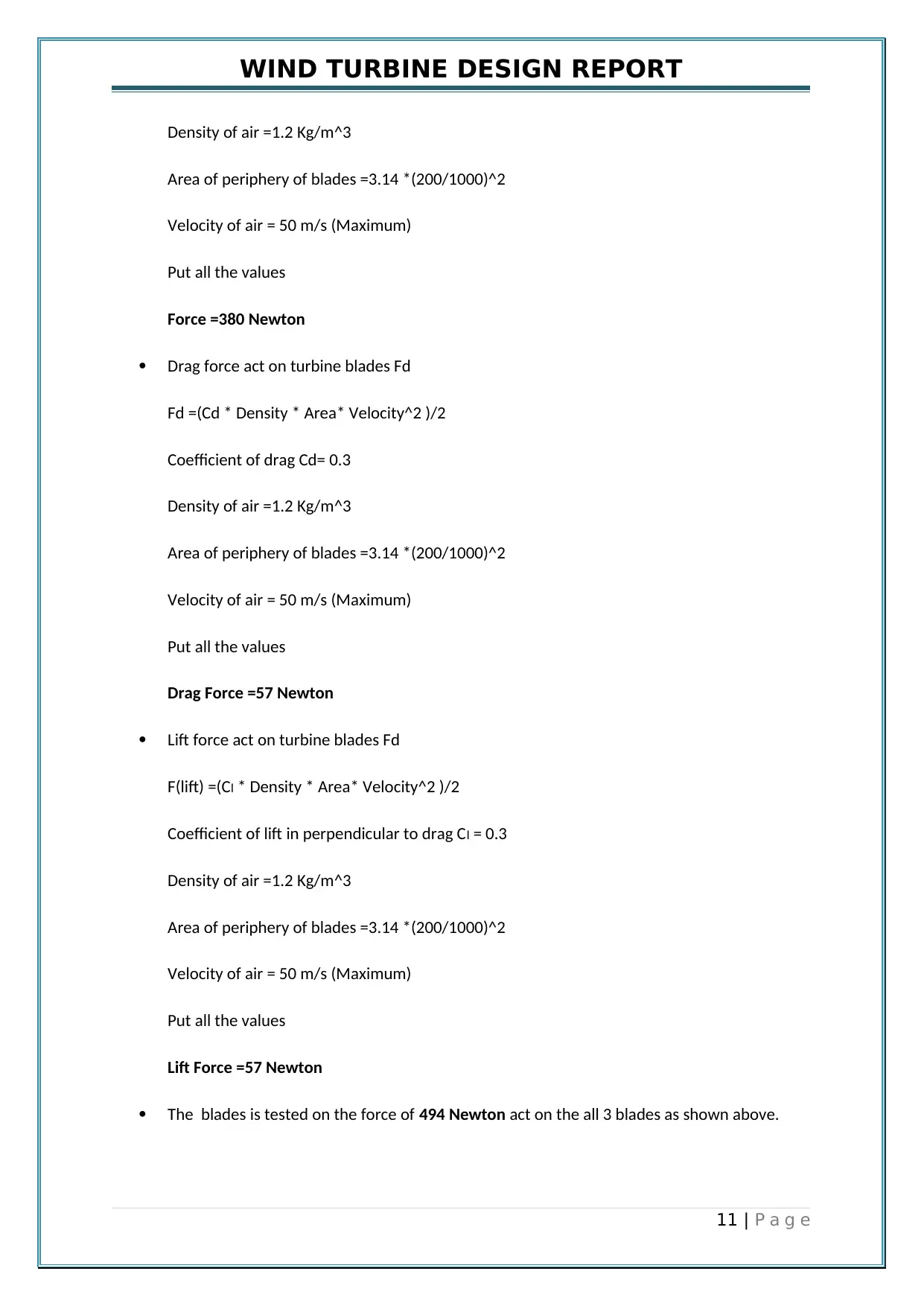
WIND TURBINE DESIGN REPORT
Density of air =1.2 Kg/m^3
Area of periphery of blades =3.14 *(200/1000)^2
Velocity of air = 50 m/s (Maximum)
Put all the values
Force =380 Newton
Drag force act on turbine blades Fd
Fd =(Cd * Density * Area* Velocity^2 )/2
Coefficient of drag Cd= 0.3
Density of air =1.2 Kg/m^3
Area of periphery of blades =3.14 *(200/1000)^2
Velocity of air = 50 m/s (Maximum)
Put all the values
Drag Force =57 Newton
Lift force act on turbine blades Fd
F(lift) =(Cl * Density * Area* Velocity^2 )/2
Coefficient of lift in perpendicular to drag Cl = 0.3
Density of air =1.2 Kg/m^3
Area of periphery of blades =3.14 *(200/1000)^2
Velocity of air = 50 m/s (Maximum)
Put all the values
Lift Force =57 Newton
The blades is tested on the force of 494 Newton act on the all 3 blades as shown above.
11 | P a g e
Density of air =1.2 Kg/m^3
Area of periphery of blades =3.14 *(200/1000)^2
Velocity of air = 50 m/s (Maximum)
Put all the values
Force =380 Newton
Drag force act on turbine blades Fd
Fd =(Cd * Density * Area* Velocity^2 )/2
Coefficient of drag Cd= 0.3
Density of air =1.2 Kg/m^3
Area of periphery of blades =3.14 *(200/1000)^2
Velocity of air = 50 m/s (Maximum)
Put all the values
Drag Force =57 Newton
Lift force act on turbine blades Fd
F(lift) =(Cl * Density * Area* Velocity^2 )/2
Coefficient of lift in perpendicular to drag Cl = 0.3
Density of air =1.2 Kg/m^3
Area of periphery of blades =3.14 *(200/1000)^2
Velocity of air = 50 m/s (Maximum)
Put all the values
Lift Force =57 Newton
The blades is tested on the force of 494 Newton act on the all 3 blades as shown above.
11 | P a g e
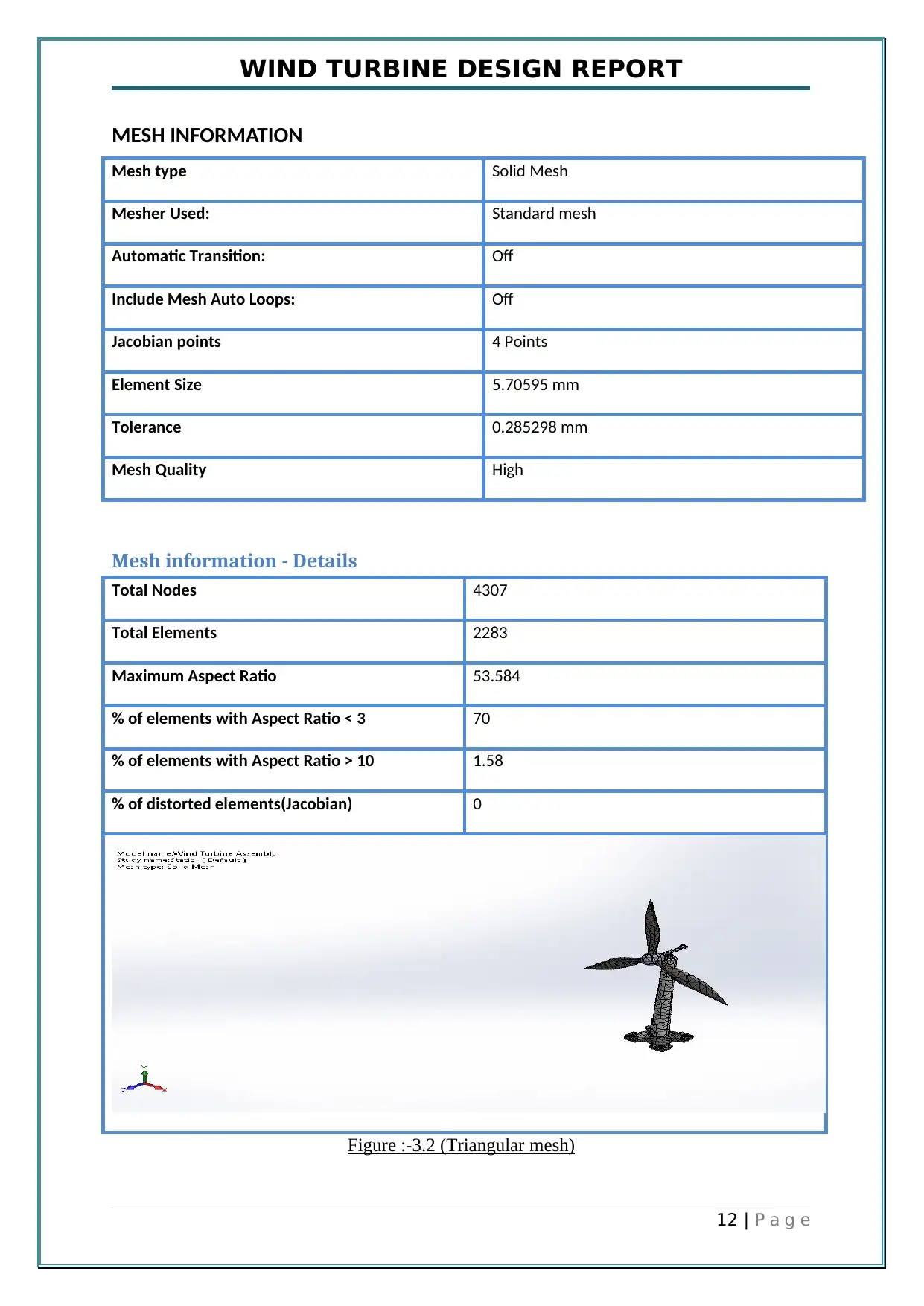
WIND TURBINE DESIGN REPORT
MESH INFORMATION
Mesh type Solid Mesh
Mesher Used: Standard mesh
Automatic Transition: Off
Include Mesh Auto Loops: Off
Jacobian points 4 Points
Element Size 5.70595 mm
Tolerance 0.285298 mm
Mesh Quality High
Mesh information - Details
Total Nodes 4307
Total Elements 2283
Maximum Aspect Ratio 53.584
% of elements with Aspect Ratio < 3 70
% of elements with Aspect Ratio > 10 1.58
% of distorted elements(Jacobian) 0
Figure :-3.2 (Triangular mesh)
12 | P a g e
MESH INFORMATION
Mesh type Solid Mesh
Mesher Used: Standard mesh
Automatic Transition: Off
Include Mesh Auto Loops: Off
Jacobian points 4 Points
Element Size 5.70595 mm
Tolerance 0.285298 mm
Mesh Quality High
Mesh information - Details
Total Nodes 4307
Total Elements 2283
Maximum Aspect Ratio 53.584
% of elements with Aspect Ratio < 3 70
% of elements with Aspect Ratio > 10 1.58
% of distorted elements(Jacobian) 0
Figure :-3.2 (Triangular mesh)
12 | P a g e
⊘ This is a preview!⊘
Do you want full access?
Subscribe today to unlock all pages.

Trusted by 1+ million students worldwide
1 out of 17
Related Documents
Your All-in-One AI-Powered Toolkit for Academic Success.
+13062052269
info@desklib.com
Available 24*7 on WhatsApp / Email
![[object Object]](/_next/static/media/star-bottom.7253800d.svg)
Unlock your academic potential
Copyright © 2020–2025 A2Z Services. All Rights Reserved. Developed and managed by ZUCOL.





